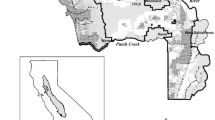Abstract
Protected wildlife corridors can help counteract habitat fragmentation and link isolated reserve “islands” into connected reserve systems. The need for wildlife corridors will grow as expanding human populations place increasing pressure on remaining undeveloped land. A two‐objective zero–one programming model is formulated for the problem of selecting land for a system of wildlife corridors that must connect a known set of existing reserves or critical habitat areas. This problem is modeled as a network Steiner tree problem, under the objectives of minimizing corridor land costs and minimizing the amount of unsuitable land within the corridor system. Linear programming is used to find exact solutions with little or no branching and bounding, and the multi‐objective weighting method is used to generate non‐inferior alternatives. Two hypothetical examples demonstrate the model and solution procedure. Results can help inform planning and decision making for protected area land acquisition and habitat restoration.
Similar content being viewed by others
References
J.C. Allen, Multiobjective regional forest planning using the noninferior set estimation (NISE) method in Tanzania and the United States, Forest Science 32(2) (1986) 517.
J.E. Beasley, An algorithm for the Steiner problem in graphs, Networks 14 (1972) 147.
R.L. Church, D.M. Stoms and F.W. Davis, Reserve selection as a maximal covering location problem, Biological Conservation 76(2) (1996) 105.
J.L. Cohon, Multiobjective Programming and Planning (Academic Press, New York, 1978).
CPLEX Optimization, Using the CPLEX Linear Optimizer (CPLEX Optimization, Inc., Houston, TX, 1990).
S.E. Dreyfus and R.A. Wagner, The Steiner problem in graphs, Networks 1 (1972) 195.
R.T.T. Forman, Lanscape corridors: from theoretical foundations to public policy, in: Nature Conservation 2: The Role of Corridors, eds. D.A. Saunders and R.J. Hobbs (Surrey Beatty & Sons, New South Wales, 1991) p. 71.
S.L. Hakimi, Steiner's problem in graphs and its implications, Networks 1 (1971) 113.
L.D. Harris and J. Scheck, From implications to applications: the dispersal corridor principle applied to the conservation of biological diversity, in: Nature Conservation 2: The Role of Corridors, eds. D.A. Saunders and R.J. Hobbs (Surrey Beatty & Sons, New South Wales, 1991) p. 189.
F.K. Hwang, D.S. Richards and P. Winter, The Steiner Tree Problem (North-Holland, Amsterdam, 1992).
R.L. Keeney and H. Raiffa, Decisions With Multiple Objectives: Preferences and Value Tradeoffs (Wiley, New York, 1976).
N. Maculan, The Steiner problem in graphs, in: Surveys in Combinatorial Optimization, eds. S. Martello, G. Laporte, M. Minoux and C. Ribeiro, Annals of Discrete Mathematics, Vol. 31 (North-Holland, Amsterdam, 1987) p. 185.
C.C. Mann and M.L. Plummer, The high cost of biodiversity, Science 260 (1993) 1868.
C.C. Mann and M.L. Plummer, Are wildlife corridors the right path?, Science 270 (1995) 1428.
C. Margules, A.J. Higgs and R.W. Rafe, Modern biogeographic theory: are there any lessons for nature reserve design?, Biological Conservation 24 (1982) 115.
R.B.B. Mwalyosi, Ecological evaluation for wildlife corridors and buffer zones for Lake Manyara National Park, Tanzania, and its immediate environment, Biological Conservation 57 (1991) 171.
G.L. Nemhauser and L.A. Wolsey, Integer and Combinatorial Optimization (Wiley, New York, 1988).
R.L. Pressey, H.P. Possingham and J.R. Day, Effectiveness of alternative heuristic algorithms for identifying indicative minimum requirements for conservation reserves, Biological Conservation, in press.
R.L. Pressey, H.P. Possingham and C.R. Margules, Optimality in reserve selection algorithms: when does it matter and how much?, Biological Conservation 79 (1996) 259.
R.B. Primack, Essentials of Conservation Biology (Sinauer Associates, Sunderland, MA, 1993).
L.M. Rasmussen, Zero-one programming with multiple criteria, European Journal of Operational Research 26 (1986) 83.
H.M. Salkin and K. Mathur, Foundations of Integer Programming (Elsevier, New York, 1989).
D.A. Saunders and R.J. Hobbs, eds., Nature Conservation 2: The Role of Corridors (Surrey Beatty & Sons, New South Wales, 1991).
D.A. Saunders and R.J. Hobbs, The role of corridors in conservation: what do we know and where do we go?, in: Nature Conservation 2: The Role of Corridors, eds. D.A. Saunders and R.J. Hobbs (Surrey Beatty & Sons, New South Wales, 1991) p. 421.
J. Sessions, Solving for habitat connections as a Steiner network problem, Forest Science 38 (1992) 203.
D. Simberloff and J. Cox, Consequences and costs of conservation corridors, Conservation Biology 1 (1987) 63.
M.E. Soulé, Land use planning and wildlife maintenance, Journal of the American Planning Association 57 (1991) 313.
M.E. Soulé and M.E. Gilpin, The theory of wildlife corridor capability, in: Nature Conservation 2: The Role of Corridors, eds. D.A. Saunders and R.J. Hobbs (Surrey Beatty & Sons, New South Wales, 1991) p. 3.
M.E. Soulé and D. Simberloff, What do genetics and ecology tell us about the design of nature reserves?, Biological Conservation 35 (1986) 19.
E.L. Ulungu and J. Teghem, Multi-objective combinatorial optimization problems: a survey, Journal of Multi-Criteria Decision Analysis 3 (1994) 83.
L.G. Underhill, Optimal and suboptimal reserve selection algorithms, Biological Conservation 70 (1994) 85.
J.C. Williams and C.S. ReVelle, A 0–1 programming approach to delineating protected areas, Environment and Planning B: Planning and Design 23 (1996) 607.
J.C. Williams and C.S. ReVelle, Applying mathematical programming to reserve selection, Environmental Modeling and Assessment, in press.
J.C. Williams and C.S. ReVelle, Reserve assemblage of critical areas: a zero-one programming approach, European Journal of Operational Research, in press.
P. Winter, Steiner problems in networks: a survey, Networks 17 (1987) 129.
R.T. Wong, A dual ascent approach for Steiner tree problems on a directed graph, Mathematical Programming 28 (1984) 271.
Author information
Authors and Affiliations
Rights and permissions
About this article
Cite this article
Williams, J.C. Delineating protected wildlife corridors with multi‐objective programming. Environmental Modeling & Assessment 3, 77–86 (1998). https://doi.org/10.1023/A:1019006721277
Issue Date:
DOI: https://doi.org/10.1023/A:1019006721277




